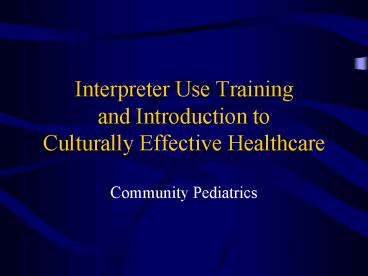Interpreter Use Training and Introduction to Culturally Effective Healthcare - PowerPoint PPT Presentation
Title:
Interpreter Use Training and Introduction to Culturally Effective Healthcare
Description:
State Legislatures. Department of Health and Human Services (DHHS) ... Administration and organizational accommodations. Interpreter Use Data ... – PowerPoint PPT presentation
Number of Views:91
Avg rating:3.0/5.0
Title: Interpreter Use Training and Introduction to Culturally Effective Healthcare
1
Interpreter Use Training and Introduction to
Culturally Effective Healthcare
- Community Pediatrics
2
COMMUNITY PEDIATRICS
3
Goals1 Introduce Cultural Competence
Concepts2 Learn Interpreter Use Skills
- Objectives
- Define cultural competency
- Mandates for use
- Research supporting use
- Explore Interpreter use skills
- Discuss service at CPMC and barriers to
interpreter use
4
Cultural Competency
- Synonyms
- Culturally effective health care
- Culturally sensitive health care
- Cross-cultural medicine
- Multiculturalism
5
Culturally Effective Healthcare
- Appropriate physician knowledge, understanding,
and appreciation of cultural distinctions - Takes into account the beliefs, values, actions,
customs, and unique health care needs of distinct
population groups - Strengthens the physician-patient relationship
and maximizes the health status of patients
6
Racial and Ethnic Health Disparities
7
Increased Focus on Training
- AAP
- APA
- AMA
- STFM
- LCME
- State Legislatures
- Department of Health and Human Services (DHHS)
8
DHHS National Standards for Culturally and
Linguistically Appropriate Services in Health
Care --issued December 2000
- Primary aim is the elimination of racial and
ethnic health disparities - Standards focus on access to care in the
patients language
9
Research
- Can Cultural Competency Reduce Racial and Ethnic
Disparities?2
10
Cultural Competency Techniques2
- Interpreter services
- Recruitment and retention policies
- Training
- Coordinating with traditional healers
- Use of community health workers
- Culturally competent health promotion
- Including family and/or community members
- Immersion into another culture
- Administration and organizational accommodations
11
Interpreter Use Data
- Negative impact of language barriers on
- Utilization
- Satisfaction
- Adherence
12
Why Use an Interpreter?
- Quality of care/health outcomes
- Legal ramifications
- Financial concerns
13
Laws Pertaining to the Provision of Interpreter
Services
- The Americans with Disabilities Act (1991)
- Hill Burton Act (1946)
- Title VI of the Civil Rights Act (1964)
- New York State Public Health Law 405.7
14
Interpreter Use Training
- Goals
- Improved health care delivery to low proficiency
English patients and families - Improved provider satisfaction and fulfillment
15
VideoCommunicating Effectively Through An
Interpreter
16
Interpreter Services at NY Childrens Hospital
- Onsite Volunteer Interpreter Services
- Remote professional Pacific Interpreters
17
Strategies for Working with Limited-English
Speaking or Low Literacy Skilled Patients3
- Speak S L O W L Y
- Use a Normal Tone of Voice
- Avoid Jargon and Slang
- A Picture is worth a thousand words
- Use the show me approach when appropriate
- Limit visit goals
- Continued
18
Strategies for Working with Limited-English
Speaking or Low Literacy Skilled Patients3
- Repeat instructions
- Attempt to verify understanding of important
points - Avoid invasive, not easily understood procedures
at the first visit - Avoid talking down to parents
- Demonstrate RESPECT
19
(No Transcript)
20
The Role of Language in Communicating in Health
Care3
- Communication forms
- Written
- Spoken
- Non-Verbal or Body Language
- Sign
21
Challenges for Language Communication3
- Non-Primary Vs Primary
- Slang
- Medical Vs Lay terminology
- Literacy
- Speed
- Dialects
- Culturally appropriate
- Use and misuse of Interpreters
- Family roles as communicators
- Gender roles in communication
22
How to Choose an Interpreter3
- Use a professionally trained interpreter (if
possible). - Avoid using hospital personnel who are bilingual
if they have not had training as an interpreter. - Avoid using family members as interpreters,
especially those of a different age or gender
from the patient. - Do not use children to interpret.
- Be sensitive to the patients right to privacy
and their choice of who should act as an
interpreter.
23
How to Work with an Interpreter
24
The Pre-Visit3
- Encourage the interpreter to meet with the
patient before the interview when possible meet
with the interpreter yourself ahead of time. - Advise the interpreter where you want them to sit
- Establish the context and nature of the visit
- Ask the interpreter if they have any concerns
that they want to share with you before the visit
25
The Visit3
- Introduce the interpreter formally at the
beginning of the interview. - Direct questions to the patient, not to the
interpreter unless they are meant for the
interpreter. - Speak in short phrases.
- Avoid technical terms, abbreviations,
professional jargon, and idioms.
26
The Visit (cont)3
- Encourage the interpreter to translate the
patients own words rather than paraphrasing or
omitting information. - Watch the patients nonverbal communication
- Be patient. An interpreted interview takes
longer.
27
References
- 1. American Academy of Pediatrics Committee of
Pediatric Workforce. Culturally Effective
Pediatric Care Education and Training Issues.
Pediatrics. January 1999 Vol.103 No. 1167-170 - 2. Brach, C. and Fraser, I. Can cultural
competency reduce racial and ethnic disparities?
A review and conceptual model. Medical Care
Research and Review. Vol. .57, Supplement 1,
(2000) 181217 - 3. (Welch M), Ackerman SA, Mutha SM. Culture and
Communication in Health Care A Curriculum for
Teaching Culturally Appropriate Care to Health
Professionals (Workbook in development). The
Network and Center for Health Care Professions,
University of California, San Francisco 2000.































